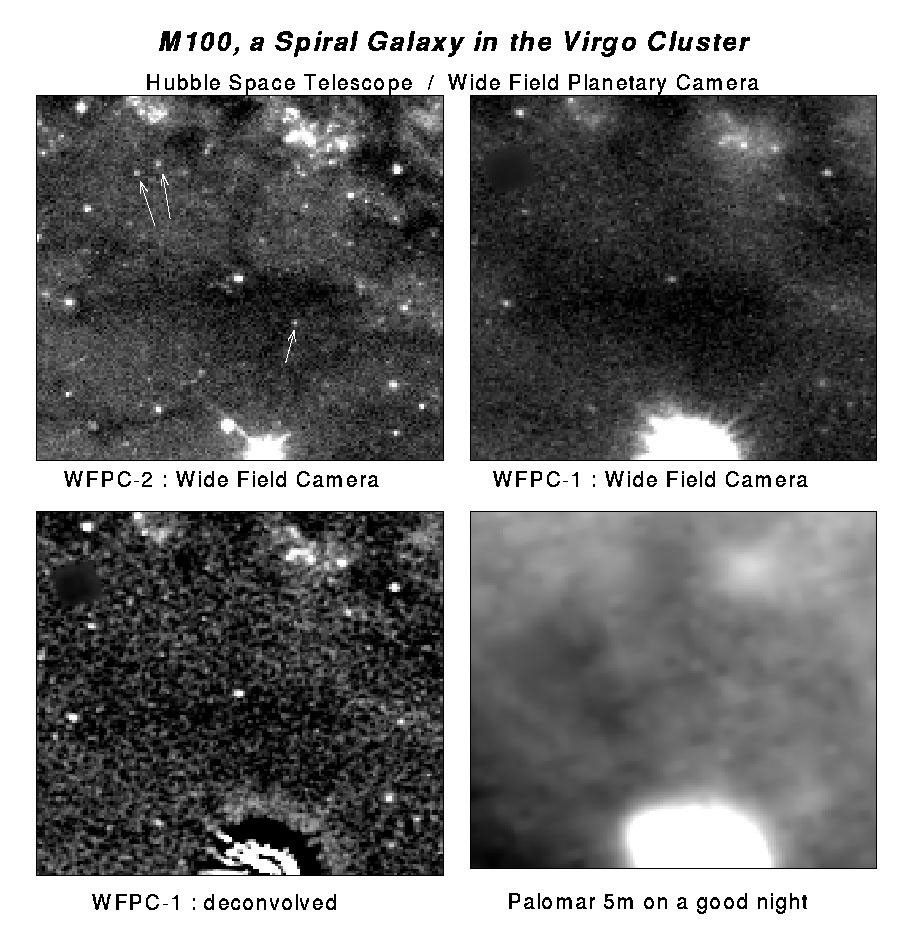1 min read
Galaxy M100 Resolution Comparison

This sequence of pictures shows successive steps in optical improvement from ground based telescopes to the newly improved Hubble Space Telescope and demonstrates the unique capability of the repaired HST. HST offers superb resolution, which allows astronomers to distinguish individual afar. in other galaxies. The resolution also allows very faint stars to be seen. This set of pictures demonstrates that the repaired HST can see stars which could never before be detected.
[upper left] An outer region in the galaxy M100 as imaged by Hubble Space Telescope's second generation Wide Field/Planetary Camera (WFPC-2). The WFPC-2 incorporates modified optics that correct for the aberration of the primary mirror on the HST. While this image is not as visually spectacular as the image of the core of the galaxy, if demonstrates one of the moat important improvements in the capability of the telescope achieved during the HST servicing mission - the ability to detect and measure the light from individual faint stare in distant galaxies. Note in particular the star indicated by the arrows, which have the approximate brightness expected for Cepheid variables in M100. While these specific stars may not be Cepheids, repeated measurements of hundreds of stars of similar brightness spread throughout the galaxy' are expected to turn up several dozens of Cepheids. By accurately measuring the brightness of these "standard candles," astronomers will use the WFPC-2 to determine an accurate distance to M100. When combined with similar measurements for other galaxies, this distance will provide a crucial link in the chain that astronomers use to determine the expansion rate, age, and size of the universe.
[upper right] A picture taken with the WFPC-1 camera on November 27, 1993, just a few days prior to the STS-61 servicing mission. The resolution in the WFPC-1 image represents a significant improvement over what can be seen from the ground - a fact that has allowed a wealth of fascinating science to be carried out with the HST since it's launch in 1990. However, only the brightest objects seen in the frame to the left could be seen before the servicing mission. The faint objects, which are critical for determining the distance to the galaxy, and for studies of stellar populations, star formation and evolution, and galactic structure, cannot be seen because of the optical aberration present before servicing.
[lower left] This panel shows the WFPC-1 image after computer image reconstruction, using algorithms commonly used on Hubble pictures taken before the servicing mission. Although these algorithms can significantly sharpen up features in the original picture, they do not allow the recovery of faint objects; many stare which are detected In the WFPC-2 image cannot even be seen, let alone measured, in the reconstructed WPPC-1 Image. Also note that the relative brightness of many objects which can be seen in the reconstructed WFPC-1 image differ from the true brightness apparent in the WFPC-2 Image. This demonstrates that even in cases where image reconstruction could recover interesting morphological information on bright objects, it could not recover the quantitative information that can now be obtained with the WFPC.2.
[lower right] An image of the same region in M100 taken with the 200 inch Hale Telescope located on top of Mt. Palomar In California. The resolution is just under an arc second, which is slightly better than typical night sky conditions for ground based observing.
About the Object
- R.A. PositionR.A. PositionRight ascension – analogous to longitude – is one component of an object's position.12h 22m 54.94s
- Dec. PositionDec. PositionDeclination – analogous to latitude – is one component of an object's position.15° 49' 19.49"
- Object NameObject NameA name or catalog number that astronomers use to identify an astronomical object.M100, NGC 4321
- Release DateJanuary 13, 1994
- Science ReleaseGalaxy M100 Resolution Comparison
- Credit
Share
Details
Claire Andreoli
NASA’s Goddard Space Flight Center
Greenbelt, Maryland
claire.andreoli@nasa.gov































